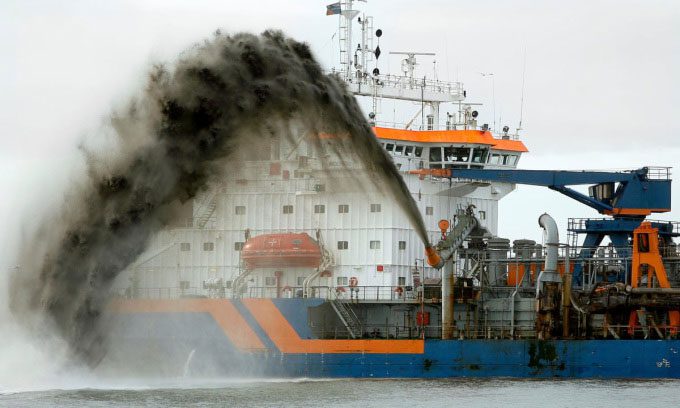The rate of marine sand extraction is increasing globally, causing severe damage to marine life and coastal communities.
According to Marine Sand Watch, a new data platform developed by the United Nations Environment Programme (UNEP), approximately one million truckloads of sand are extracted from the world’s oceans every day, posing a serious threat to marine organisms and the coastal communities that are already facing storms and rising sea levels, Guardian reported on September 5.

A dredging boat spraying sand in the Netherlands. (Photo: Reuters).
The new data platform monitors marine sand dredging based on AIS (Automatic Identification System) data from vessels. Using data from 2012 to 2019, Marine Sand Watch estimates that the dredging industry extracts 6 billion tons of marine sand each year. UNEP indicates that the extraction rate is increasing globally and is nearing the natural replenishment rate of 10 to 16 billion tons of sediment that flows into the oceans each year.
Marine Sand Watch identifies several “hotspots” including the North Sea, Southeast Asia, and the eastern coast of the United States. In many areas, including certain regions in Asia, extraction activities are more intense, and marine sand is being extracted at a rate that exceeds natural replenishment.
“The environmental impact of dredging and extracting from shallow marine areas is alarming, including biodiversity loss, water turbidity, and noise pollution affecting marine mammals.” Pascal Peduzzi, head of the GRID-Geneva analysis center at UNEP, which developed Marine Sand Watch, stated.
Marine Sand Watch has trained artificial intelligence (AI) to identify the movements of dredging vessels using AIS data. The platform has data from 2012 to 2019 from Global Fishing Watch, a company monitoring commercial fishing activities, and is currently researching newer data.
Sand and gravel account for half of the total materials extracted globally. Globally, 50 billion tons of sand and gravel are used each year – equivalent to a wall 27 meters high and 27 meters wide stretching around the equator. They are essential components of concrete and asphalt.
While sand extracted from land mines can be somewhat replenished, extracting sand and other materials from river and marine environments alters the shape of rivers or coastlines. “Dredging ships are like giant vacuum cleaners on the seabed. All the microorganisms in the sand are crushed with nothing left. If all the sand is removed and only bare rock is left, it cannot recover. But if 30 to 50 cm is left, it will recover,” Peduzzi explained.


















































